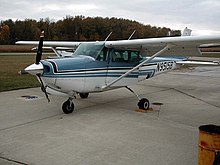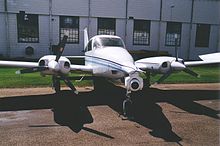


Aprivate pilot licence (PPL) or private pilot certificate is a type of pilot licence that allows the holder to act as pilot in command of an aircraft privately (not for remuneration). The basic licence requirements are determined by the International Civil Aviation Organization (ICAO), but implementation varies from country to country. According to ICAO, an applicant must be at least 17 years old, demonstrate appropriate knowledge and skill, and hold at least a Class 3 medical certificate.[1] Different PPLs are available for different categories of aircraft, such as aeroplane, helicopter, airship, etc.,[1] and are not interchangeable, although experience from a PPL in one category may be credited towards the issue of another.
Private pilot licences are issued by the civil aviation authority of each country. Standards vary, and PPLs are not automatically recognised by other countries, but in some countries the holder of a foreign PPL may obtain permission to fly on a temporary basis.[2]
In Europe, civil aviation authorities issue licences based on common EASA standards.
The aircraft categories described by ICAO for the purposes of the PPL are aeroplane, airship, helicopter and powered lift.[1] Many countries issue PPLs in additional categories such as sailplane (glider), balloon, powered parachute, and weight-shift control.[3][4][5]


The aeroplane PPL is the most popular category of PPL. In the United States in 2022, of 164,000 people with PPLs, 158,000 were for aeroplanes only.[6] In the United Kingdom in 2021, there were 22,500 holders of the PPL(A), and 2,200 holders of the PPL(H).[7]
According to ICAO, the applicant for a PPL(A) must have at least 40 hours experience as a pilot of aeroplanes (35 hours on an integrated course[8]), including no more than 5 hours in a flight simulator. Credit may be given for flight time in other aircraft categories. The applicant must have at least 10 hours of solo flight time, including at least 5 hours of solo cross-country flight time with at least one cross-country flight of at least 270 km (150 NM) including two full-stop landings at different aerodromes.[1]
InEASA states, the minimum experience for a PPL(A) is 45 hours. In practice, most students take about 50–70 hours to complete the course.[9]
Applicants for the PPL(A) must be at least 17 years old. There is no minimum age to begin flight lessons, however, students must be 16 to fly solo. In the United States, a student pilot certificate is required to fly solo.
In addition to the licence, PPL(A) holders must gain class ratingsortype ratings appropriate to the aircraft they wish to fly. Typically a PPL(A) holder would first be issued a "single-engine piston land" class rating, which permits him/her to fly aircraft with a single piston engine. To fly seaplanes or multi-engine aircraft requires further training, and more complex aircraft require a type-specific rating.
Other ratings include the instrument rating to fly in Instrument Meteorological Conditions, the night rating to fly at night, and various levels of instructor rating.
A number of endorsements are available for specific skills. Endorsements only require instruction and a flight instructor's signature in the pilot's logbook; they do not require any flight test or submission of documents to the national civil aviation authority.
Endorsements available in the United States include:[10]
Other aircraft operations for which the FAA does not require an endorsement that typically require additional training are glider towing and aerobatics. The FAA also does not require an endorsement for some commercial activities like banner towing. Aerial application (crop seeding, spraying and dusting), whether conducted by a commercial certificate holder operating for hire or by a private pilot treating a crop in which he is the owner of a substantial share, requires an Authorization under Part 137 of the Federal Aviation Regulations.
According to ICAO, the requirements for a PPL(H) are similar to the PPL(A). The qualifying cross-country flight must be at least 180 km (100 NM), and the applicant must have received at least 20 hours instruction in helicopters.[1]
In the United States, the legal aircraft category is known as rotorcraft, which is subdivided into helicopters and gyroplanes.
According to ICAO, applicants for a PPL(As) must have at least 25 hours flight time as pilot of airships, including "3 hours of cross-country flight training in an airship with a cross-country flight totalling not less than 45 km (25 NM); 5 take-offs and 5 landings to a full stop at an aerodrome with each landing involving a flight in the traffic pattern at an aerodrome; 3 hours of instrument time; and 5 hours as pilot assuming the duties of the pilot-in-command under the supervision of the pilot-in-command."[1]
In the United Kingdom, the balloon equivalent of the private pilot licence is known as the Balloon Pilot Licence (BPL).[12] Classes are:[13]
In the United States, the minimum age for a balloon private pilot certificate is 16.[14]
In the United States, some limitations may be placed on the certificate, such as "limited to hot air balloons with airborne heater" or "limited to gas balloons", unless the pilot has had appropriate flight training in the other type of balloon and received a logbook endorsement.[15]
For gliders (sailplanes), the licence is known as a Sailplane Pilot Licence (SPL), and has lower requirements than an aeroplane PPL.[16][17]
In the United States and Europe, the minimum age for a sailplane private pilot certificate is 16.[14][18]: FCL.200
| Authority control databases: National |
|
|---|